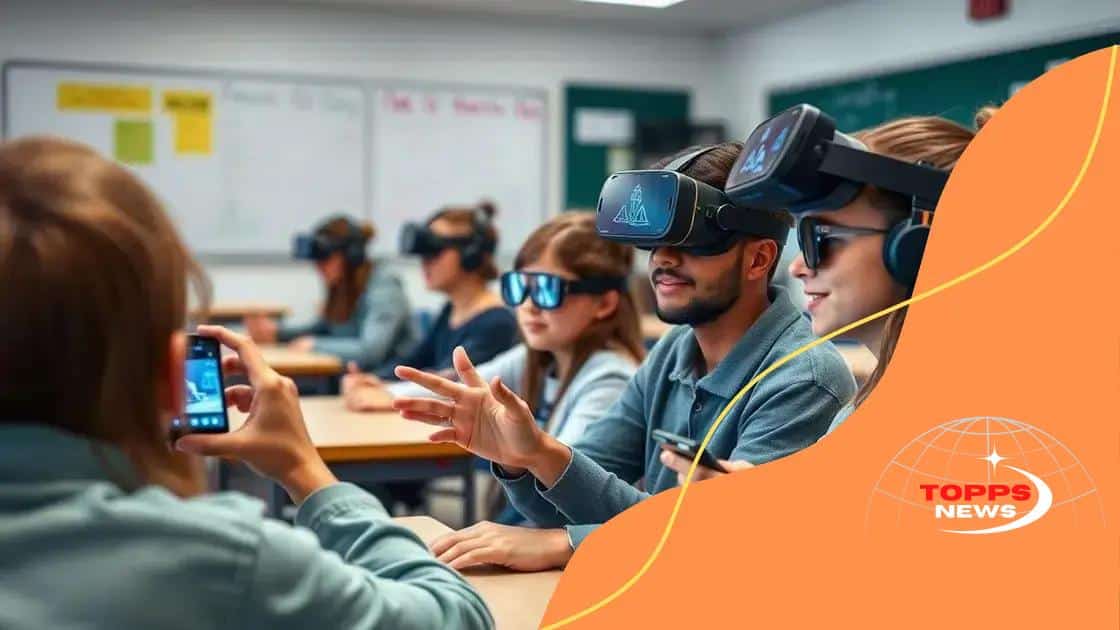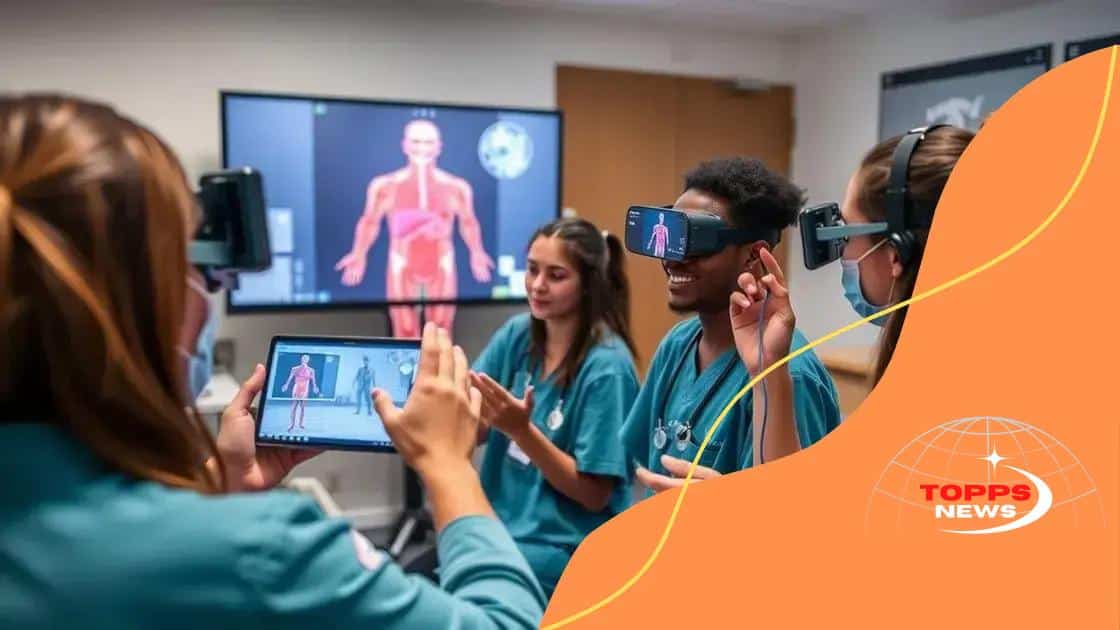How AR is being used for hands-on learning experiences

Augmented Reality (AR) is transforming education by making learning more interactive, enhancing student engagement through immersive experiences, and allowing for real-world applications that facilitate better understanding of complex subjects.
How AR is being used for hands-on learning experiences is changing the educational landscape. Imagine being able to interact with 3D models of ancient artifacts or biological systems right from your classroom. This article dives into the exciting ways AR is enhancing education.
Understanding augmented reality in education
Understanding augmented reality in education is essential as it offers innovative ways to engage students. By blending digital content with the physical world, AR creates interactive experiences that enhance learning.
The Basics of Augmented Reality
Augmented reality is more than just a fancy tool; it’s a way to enrich learning. For example, students can explore the human body in 3D or visualize complex scientific concepts right in their classroom.
Key Features of AR in Learning
- Interactive learning experiences
- Immediate access to information
- Enhanced visualization of difficult concepts
- Improved student engagement
Through these features, AR changes how students interact with their subjects. Instead of passively receiving information, they immerse themselves in the learning process. This hands-on approach allows them to better grasp the material.
Applications of Augmented Reality
Teachers utilize AR for various subjects. In history classes, students can examine ancient ruins virtually, while in biology, they might dissect a frog digitally. These applications not only make learning fun but also help students retain information longer.
By providing context and relevance, augmented reality fosters curiosity. Students are not just learning facts; they are experiencing them. This shift in engagement is crucial for modern education.
Moreover, AR can support various learning styles. Visual learners benefit from seeing concepts in action, while kinesthetic learners thrive through interactive simulations.
As AR technology continues to evolve, it will undoubtedly play a larger role in classrooms around the world. The potential to redefine education is here, and understanding how augmented reality works is the first step.
Benefits of AR in hands-on learning
The benefits of AR in hands-on learning are impressive and transformative. By bringing learning to life, augmented reality captures students’ attention and encourages deeper understanding.
Enhanced Engagement
One major benefit of augmented reality is its ability to enhance student engagement. When learners interact with realistic simulations, they are more likely to stay focused. For instance, a student studying astronomy can explore the solar system in 3D, making the learning experience more vivid and memorable.
Improved Retention of Information
Another important advantage is the improved retention of information. Studies show that students remember content better when they experience it through interactive learning. For example, by using AR to visualize a historical event, students can retain facts and details more effectively than through traditional methods.
- Interactive experiences boost memory retention.
- Realistic scenarios make learning relatable.
- Hands-on activities enhance understanding.
- Visual aids support various learning styles.
Using AR tools also supports different learning styles, catering to visual, auditory, and kinesthetic learners. This versatility allows every student to engage in a way that suits their needs best. By making education more accessible, AR fosters a more inclusive environment.
Safe Experimentation
AR also allows students to experiment safely. In subjects like chemistry or physics, students can conduct virtual experiments without risks. They can observe reactions and processes as if they were real, encouraging curiosity and exploration. This safe environment helps students build confidence in their abilities.
Furthermore, augmented reality provides instant feedback. As students explore and learn, they receive immediate responses that help them understand their mistakes. This real-time interaction further enhances the learning experience.
Incorporating AR into the curriculum can transform the educational landscape. The accessibility, engagement, and safety that come with AR in hands-on learning make it imperative for modern educators to embrace this technology.
Real-world applications of AR technology

The real-world applications of AR technology have expanded significantly in recent years, especially in the field of education. Augmented reality is not just a futuristic concept; it is already transforming classrooms around the globe.
Healthcare Training
One major area where augmented reality shines is in healthcare training. Medical students can use AR to practice surgeries in a simulated environment. This hands-on experience allows them to hone their skills without the risks associated with real-life operations.
Interactive Learning Platforms
Many educational institutions are adopting interactive learning platforms that utilize AR. Students can explore complex subjects like biology or physics through virtual simulations. For example, a biology student can observe the human anatomy in 3D, making it easier to understand how the body works.
- Accessible learning resources for diverse subjects.
- Opportunities for students to engage with material.
- Brings theoretical concepts into a tangible form.
- Encourages teamwork through collaborative projects.
This hands-on approach not only improves understanding but also makes learning more engaging. Students report higher levels of interest and curiosity when using AR tools in their studies.
Field Trips and Virtual Exploration
Another exciting application of AR technology is its ability to enhance field trips. Students can use AR apps to access information about historical sites or museums. This technology adds an extra layer of interaction that enriches their learning experience. They can scan objects or locations and instantly receive detailed information and historical context.
In addition to traditional field trips, AR allows learners to experience places they may never visit. For instance, they can explore the Great Wall of China or the pyramids of Egypt right from their classroom. This virtual exploration broadens their worldview and allows for global connections through education.
These real-world applications of AR technology highlight its potential to change how we teach and learn. By incorporating augmented reality into education, we prepare students for a future where technology and learning are inseparably linked.
Challenges and limitations of AR in classrooms
While incorporating AR technology into classrooms offers many benefits, it is essential to recognize the challenges and limitations that come with it. These factors can affect how effectively augmented reality is integrated into education.
Technical Limitations
One of the primary challenges is the technical limitations of AR devices. Many schools may not have access to the latest AR tools or the internet connectivity required for smooth operation. This can hinder the ability of teachers to implement AR lessons.
Cost Factors
The cost of AR technologies also poses a challenge. Purchasing AR software and devices can be expensive. Many educational institutions may struggle to allocate funds for these technologies, especially when faced with budget cuts.
- AR tools can require ongoing maintenance and updates.
- Training teachers to use AR effectively adds to costs.
- Not all schools can afford advanced technology.
- Technology can become outdated quickly.
As with any new technology, training is crucial. Teachers need adequate training to use AR effectively. Without proper knowledge and skills, the benefits of augmented reality may not be fully realized.
Resistance to Change
There can also be resistance to change among educators. Some teachers may feel uncomfortable using technology in their classrooms. They may prefer traditional methods of teaching and hesitate to embrace a new, unfamiliar approach.
Moreover, students’ varied learning styles can impact the success of AR in classrooms. While many students thrive in interactive environments, some may find it distracting or overwhelming. It’s essential for teachers to balance AR activities with traditional approaches to cater to all learning preferences.
Finally, content limitations can arise. There may be a lack of quality AR educational resources available for certain subjects or grade levels. Without enough engaging content, teachers might be hesitant to adopt AR into their lesson plans.
Future trends in AR for education
The future trends in AR for education promise to enhance learning experiences even further. As technology advances, we can expect to see more innovative uses of augmented reality in classrooms.
Increased Accessibility
One significant trend is the focus on increasing accessibility. Augmented reality will become more affordable and widely available, making it easier for schools to adopt. This accessibility will allow more students, regardless of their location, to benefit from interactive learning.
Integration with Other Technologies
Another promising trend is the integration of AR with other technologies, like virtual reality (VR) and artificial intelligence (AI). These combined technologies can create immersive learning environments where students can explore complex subjects in depth.
- Blended learning models will gain popularity.
- AI will personalize AR experiences for each student.
- Cross-compatibility with various devices will expand.
- More interactive platforms will emerge.
As technology continues to evolve, we will see AR applications that adapt to individual student needs. This personalization can lead to better engagement and improved outcomes.
Gamification of Learning
Gamification will play a significant role in the future of AR in education. By incorporating game elements into learning experiences, students will be motivated to engage more deeply. AR can create real-world challenges that encourage teamwork and problem-solving.
Also, educators can design games that relate to their curriculum, enhancing the educational value. This approach not only makes learning fun but also promotes retention of information.
As the future unfolds, AR technology will likely lead to innovative breakthroughs in how we teach and learn. These trends show the potential for AR to fundamentally transform education, making it more engaging and effective for students everywhere.
FAQ – Frequently Asked Questions about Augmented Reality in Education
What is augmented reality (AR) in education?
Augmented reality in education is a technology that overlays digital information, such as images and videos, onto the real world, enhancing the learning experience.
How can AR improve student engagement?
AR can improve student engagement by providing interactive and immersive experiences that make learning more enjoyable and memorable.
What are some challenges of using AR in classrooms?
Some challenges include technical limitations, cost factors, and the need for effective teacher training to utilize AR effectively.
What future trends can we expect for AR in education?
Future trends include increased accessibility, integration with other technologies, and gamified learning experiences that enhance student motivation and interaction.





